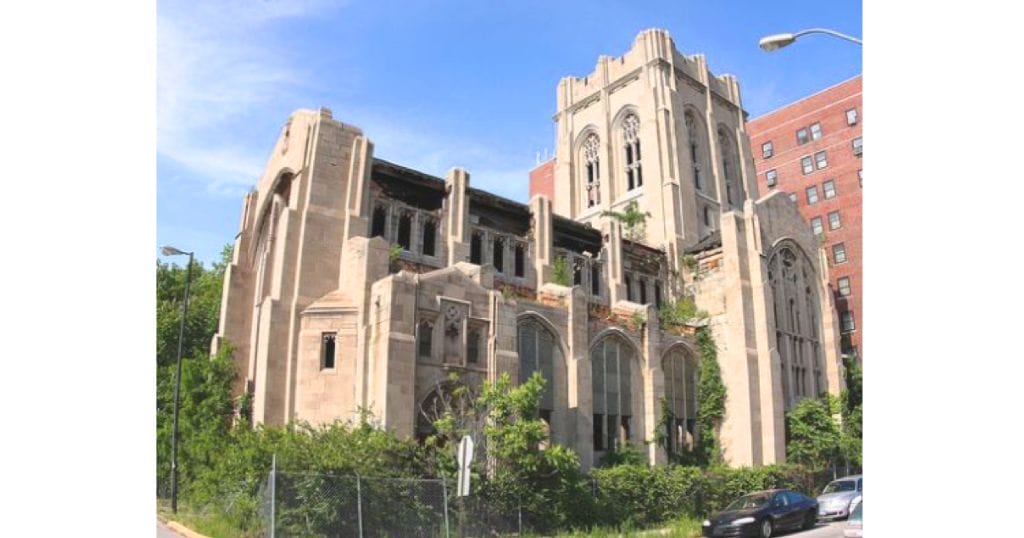Abandoned City Methodist Church among three Gary finalists for $5 million grant
For decades it stood as an abandoned symbol of Gary’s decline. The haunting, empty gothic sanctuary of the historic City Methodist Church has attracted gawkers, tourists, even Hollywood filmmakers seeking to capitalize on its grandiose interior that is now a creepy setting with its piles of rubble, and collapsed ceiling.
Now, City Methodist Church, once the gracious site of Gary’s well-heeled before it was abandoned during an era of white flight, could become a place where couples could exchange vows under towering columns and dance the night away under a roofless relic and a moonlit sky.
It’s part of a proposal to transform one of Gary’s most prominent buildings into an open air space for a wedding and reception hall. If it succeeds, the project would turn a 92-year-old decaying landmark that for over 40 years served as an eerie attraction where history and hardship came together.
Called the “Gary Ruins Garden,” the proposal took a big step to becoming a reality on January 17, when it’s creator, Gary Redevelopment Deputy Director Jack Eskin was selected as a finalist in the prestigious John S. and James L. Knight Foundation’s Knight Cities Challenge, an annual national competition that encourages applicants to come up with ideas to make their city more successful.
As it turns out, City Methodist Church was one of three entries from Gary that are among 144 finalists from cities across the country. The other two entries are “Ballpark Plaza,” an idea to turn a vacant lot across the street from the U.S. Steel Yard on 5th Avenue east of Broadway into an outdoor entertainment center and farmer’s market. The project was submitted by Brenda Scott-Henry, director of Gary’s Department of Environmental and Green Urbanism Affairs. Scott-Henry submitted on behalf of Kenneth A. Pharr, who died in December.
The third proposal, “In Love with Gary, Indiana,” would establish the city as a unique and inexpensive urban wedding destination. Submitted by Dana Crawford of SmithGroup JJR, the project aims to boost economic opportunities in Gary and change the city’s narrative.
For the second consecutive year, Detroit and Philadelphia top the list of finalists, with 21 and 20 proposals respectively. San Jose, California, represented with eight projects. Applicants from Charlotte, North Carolina produced 12 finalists, according to the foundation’s website. It’s unclear whether this is the first year that Gary has had a finalist or if this was the most the city has had in the competition’s three-year history.
Competition in the challenge is so intense that just being named a finalist is an honor in itself. The foundation received 4,500 applicants for 2017, surpassing the amount in the competition’s inaugural year in 2015. If the judges say “I do” to the City Methodist Church wedding proposal or the other Gary finalists, the winner will share $5 million in earnings for their projects. The winner will be announced in the Spring.
The history and mystique of City Methodist Church may just put the proposal over the top. Renowned photographers and filmmakers are attracted to the grandiose and urban scenery. Built in 1925 when Gary was a bustling steel town, City Methodist Church’s congregation included the city’s predominately white elite and movers and shakers. Located just off Broadway at 577 Washington St., the traditional English Gothic, nine-story church was built by Rev. William G. Seaman, who said the structure would last forever. The building cost $1 million to build, nearly $14 million today.
With an auditorium, basketball gym, offices majestic fireplaces, ornate windows and fine masonry, City Methodist Church at the time was considered Gary’s finest place of worship. However, because of segregation and Jim Crow laws, Blacks did not worship at City Methodist Church.
As Gary’s population became predominately Black in the 1960s, City Methodist’s affluent worshippers left the church and the city during a period of white flight. The congregation of the church dramatically shrank and remaining congregants could no longer afford the upkeep of the building. A committee held a meeting in October 1974 and decided to relocate and close the church on January 3rd, 1975. The building was sold to Indiana University as a campus extension but nothing was done with it. According to historians with Preserve Indiana, the building was used sporadically as a church by another congregation. Historians say it was also used as a local dance center and a halfway home for underprivileged children and single parents, but it eventually fell into abandonment and disuse.
Gary eventually took ownership of the building after B&R Realty in Gary turned it over to the city.
Over the years, the elegant building became the home for vagrants and homeless persons. In 1997, the roof collapsed as a fire ripped through the building. Since then, City Methodist has continued to decline, but even as the building slipped further into disrepair, it became more attractive to tourists, photographers and filmmakers. The remnants of City Methodist have been featured in numerous photo shoots. History buffs say the building has been featured in a dozen of movies, including “Nightmare on Elm Street” and “Transformers 3.”
With falling rubble and aging infrastructure, city officials erected a 10-foot fence around the property to keep tourists and gawkers out, saying the building is unsafe. Onlookers occasionally slip through the fence to take a risky glimpse of the grand and splendor of a bygone era. Too expensive to preserve or even demolish, City Methodist remains abandoned and unused. There was talk of turning it into a ruin garden, but nothing ever materialized.






